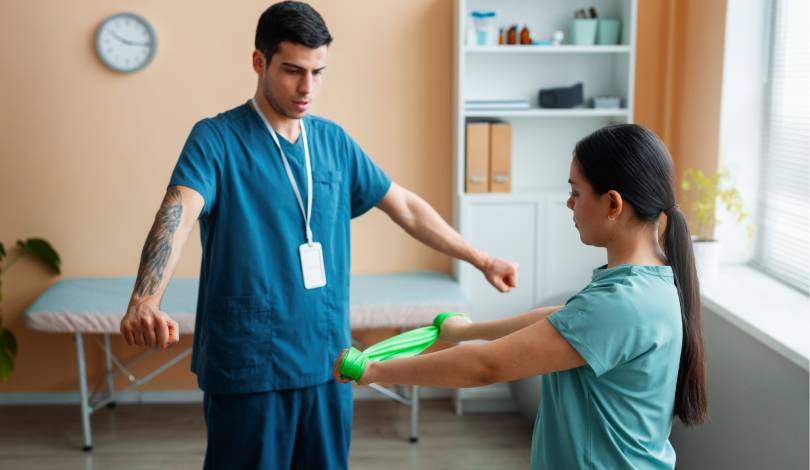Synopsis
Arm pain—whether caused by overuse, injury, or underlying conditions—can significantly affect your ability to perform daily tasks, from lifting and writing to reaching and carrying. Physiotherapy for arm pain offers targeted relief by addressing muscular imbalances, joint stiffness, and nerve impingements. This blog explores how arm physiotherapy, including physio for upper arm pain and physical therapy for arm and shoulder pain, helps restore mobility, reduce discomfort, and prevent further injury. Discover the benefits of personalised physio exercises for upper arm muscle pain, broken arm physio, and techniques used in physiotherapy for arms and shoulders. Whether your concern is chronic strain or a recent fracture, we will outline how effective physiotherapy of arm can rebuild strength, improve circulation, and enhance your quality of life. If you’re searching for lasting relief, read on to learn how expert-led physiotherapy can help you move better, feel stronger, and reclaim confidence in your arm’s function.
Table of Contents
- What Causes Arm Pain and Why It Shouldn’t Be Ignored
- The Role of Physiotherapy in Arm Pain Management
- Benefits of Arm Physiotherapy Across All Age Groups
- Understanding Physio for Upper Arm Pain
- Physical Therapy for Arm and Shoulder Pain
- Broken Arm Physio and Post-Fracture Recovery
- When to Start Physiotherapy for Arms and Shoulders
- How Orthocure Supports Long-Term Arm Recovery
What Causes Arm Pain and Why It Shouldn’t Be Ignored
Arm pain can result from repetitive strain, poor posture, trauma, or neurological conditions. It may involve joints, muscles, tendons, or nerves. While some cases are acute, many become chronic if not addressed properly. Neglecting symptoms can lead to weakness, reduced mobility, and compensatory movement in other parts of the body. Seeking physiotherapy for arm pain early ensures a quicker and more complete recovery. A thorough assessment helps pinpoint the root cause and formulate a targeted treatment plan.
The Role of Physiotherapy in Arm Pain Management
Arm physiotherapy provides a non-invasive, customised approach to treating pain, weakness, and movement restrictions. Treatment often begins with manual therapy to ease tightness, followed by structured strengthening and mobility exercises. Techniques like myofascial release, nerve gliding, and trigger point therapy are commonly used. Whether it’s post-injury or degenerative, physiotherapy for arms and shoulders helps patients regain control and functionality without dependence on medication or surgery.
Benefits of Arm Physiotherapy Across All Age Groups
From young athletes to elderly individuals, arm physiotherapy offers benefits for everyone. In children and adolescents, it helps correct movement patterns and prevents future strain. Adults benefit from improved mobility and reduced discomfort from desk jobs or manual labour. Seniors gain enhanced arm function and reduced fall risk due to improved upper body strength. Physio for upper arm pain is especially useful for people recovering from injuries or managing age-related wear and tear.
Understanding Physio for Upper Arm Pain
Upper arm pain can stem from bicep tendinitis, rotator cuff issues, or nerve compression. Physio for upper arm pain involves soft tissue release, strengthening, and joint mobilisation. Exercises are focused on the biceps, triceps, deltoids, and scapular stabilisers. Patients learn to correct posture and perform functional movements safely. Strengthening this area also supports better shoulder health. Early therapy reduces the risk of frozen shoulder or elbow complications.
Physical Therapy for Arm and Shoulder Pain
Arm and shoulder pain often overlap due to shared muscle groups and joint involvement. Physical therapy for arm and shoulder pain includes mobility drills, scapular re-education, and proprioception training. Manual therapy is used to improve joint alignment and tissue flexibility. This integrated approach helps manage conditions like shoulder impingement, cervical radiculopathy, and rotator cuff injuries. Patients report better lifting ability, less fatigue, and more confidence in arm movement.
Broken Arm Physio and Post-Fracture Recovery
Fractures in the arm require careful rehabilitation. Broken arm physio begins once the cast is removed and the bone has healed adequately. Focus is placed on regaining range of motion, reducing stiffness, and rebuilding strength. Wrist and elbow mobility are addressed simultaneously, as they often suffer from inactivity. Therapists guide patients through graduated exercises, ensuring bone safety while improving function. Ignoring rehab after a fracture can lead to long-term mobility limitations.
When to Start Physiotherapy for Arms and Shoulders
The best time to begin physiotherapy for arms and shoulders is as soon as pain or functional limitation is noticed. In cases of surgery or fracture, start when the doctor clears you for movement. Delayed intervention often results in prolonged recovery, frozen shoulder, or muscle atrophy. An early evaluation from an arm physiotherapy expert ensures personalised care and faster results. Consistency in sessions and at-home routines determines long-term success.
How Orthocure Supports Long-Term Arm Recovery
Orthocure Clinics and Gyms offer structured and protocol-driven care for all arm-related concerns. Their 4 Point Protocol—Diagnosis, Pain Relief, Structural Correction, and Maintenance—ensures each aspect of recovery is addressed. From broken arm physio to complex neurological cases, their team of physiotherapists provides evidence-based treatment. Patients benefit from integrated services including orthopaedics, fitness training, and chiropractic care, making Orthocure a one-stop destination for physiotherapy for arm pain and complete upper limb rehabilitation.
FAQs
What are the main causes of arm pain that physiotherapy can treat?
Physiotherapy treats arm pain caused by muscle strains, nerve compression, poor posture, repetitive strain, and fractures. It also addresses shoulder impingement and rotator cuff issues. Treatment plans focus on restoring joint mobility, strengthening weak areas, and improving coordination. Therapists also guide on activity modification. Early intervention ensures better recovery and long-term relief.
What does broken arm physio involve after the cast is removed?
Broken arm physio focuses on reducing stiffness, restoring motion, and regaining strength. It begins with gentle joint mobilisation and progresses to strengthening and coordination exercises. Therapists monitor healing and prevent overuse. Exercises also target the wrist and elbow to avoid secondary complications. Regular sessions improve functional use of the arm in daily activities.
How does physio for upper arm pain support muscle recovery?
Physio for upper arm pain targets muscle imbalances, inflammation, and joint dysfunction. It involves strengthening exercises for the biceps, triceps, and shoulder stabilisers. Manual therapy relieves tension and improves circulation. Patients also learn posture and movement correction. This prevents recurrence and supports long-term arm function.
Is physical therapy for arm and shoulder pain effective for desk job workers?
Yes, it’s highly effective for managing pain due to prolonged sitting, poor ergonomics, or overuse. It improves posture, reduces stiffness, and strengthens supporting muscles. Therapy also educates patients on proper desk setup and daily exercises. Regular intervention helps prevent chronic conditions. It enhances comfort and productivity in daily life.
When should I start physiotherapy for arms and shoulders?
Start physiotherapy as soon as you notice discomfort, restricted movement, or weakness. For post-surgical or post-fracture cases, begin as soon as approved by your doctor. Early treatment shortens recovery time and prevents complications. A physiotherapist will assess your condition and create a customised plan. Regular sessions and home routines ensure lasting results.





